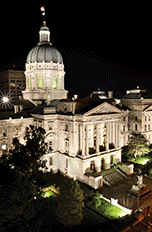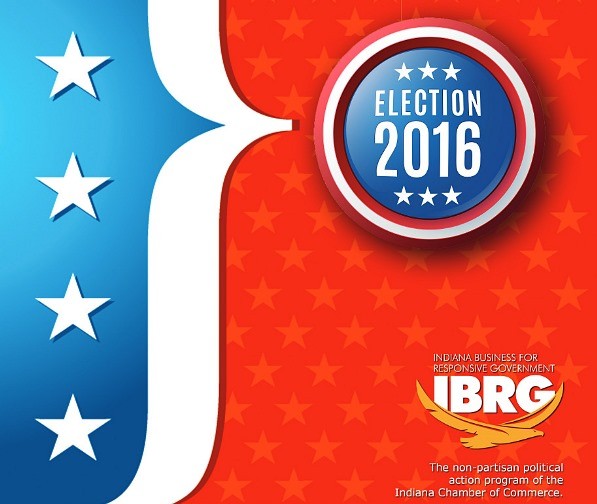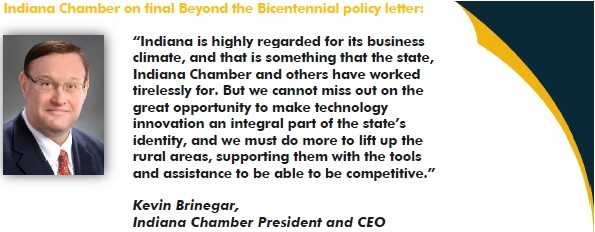
Our CEO Kevin Brinegar (far right) was on hand today in Fort Wayne as Gov. Eric Holcomb talked about the Next Level Roads Plan and its impact. An announcement was also made in Goshen. (photo via Northeast Indiana Regional Partnership)


Our CEO Kevin Brinegar (far right) was on hand today in Fort Wayne as Gov. Eric Holcomb talked about the Next Level Roads Plan and its impact. An announcement was also made in Goshen. (photo via Northeast Indiana Regional Partnership)
 Gov. Holcomb offered the following statement on the Indiana Chamber’s Indiana Vision 2025 Report Card and 10th annual workforce survey released Tuesday:
Gov. Holcomb offered the following statement on the Indiana Chamber’s Indiana Vision 2025 Report Card and 10th annual workforce survey released Tuesday:
This report card makes clear our state’s strengths and challenges: Indiana is a top state for doing business, but to meet the demands of our growing economy we must double-down on efforts to attract and prepare a ready workforce.
There is no single solution for improvement. The only way we’ll take our state to the next level is with a comprehensive strategy, and Indiana has the right roadmap.
From improving roads and bridges to attacking the drug epidemic, from prekindergarten to adult career training, from more direct flights to enhanced regional development—all of these efforts combined will help build healthier, more vibrant communities that are magnets for jobs and growth.
Now is the time for our state’s leaders to come together and put in the hard work that will improve the lives of Hoosiers.
We appreciate the governor’s support and attentiveness to our efforts.

Flanked by Gov. Eric Holcomb and Indiana Chamber President Kevin Brinegar, Ann Compton regaled Legislative Dinner attendees with her stories about past presidents, and her opinions of President Trump and the media today.
With more than 40 years of experience covering the administrations of seven presidents, former ABC News White House correspondent Ann Compton had plenty to share Tuesday night at the Indiana Chamber’s 2017 Legislative Dinner.
A few of her reflections and projections:
On the media: “In this digital age, my business, the news industry, is almost unrecognizable to me. It wounds me to hear that the free, American press is the enemy. We in the mainstream press have to work responsibly and openly to earn back your trust.”
On prior presidents and the media: George H.W. Bush originated the hat with the saying, “Annoy the Media: Re-Elect Bush” (Compton still has hers); Barack Obama “lashed out at the press” in a private, off-the-record session when he was not happy with the tone of the reporting.
On fake news sites: “They are more like criminal enterprises.”
On the ultimate test for presidents: “They are measured by the crises they face.” Compton listed several, including the younger President Bush and 9/11, sharing personal anecdotes about that day as a result of her being the only broadcast journalist on Air Force One after the attacks.
On Donald Trump: “This man is remarkably consistent (in style), but not necessarily on policy.” Noting that 30 years ago he didn’t carry a briefcase or schedule too many meetings, saying, ‘You can’t be imaginative or entrepreneurial if you’ve got too much structure.’ We’re seeing that applied today.
On looking forward: Despite her concerns, she says, “I really do believe the republic is strong, our country is strong.”
View event photos.
The Legislative Dinner, with more than 700 attendees at the Indiana Roof Ballroom, was presented by Ice Miller, with Lifeline Data Centers sponsoring the opening reception. Gold sponsors: Eli Lilly and Company, NIPSCO and St. Vincent. Silver sponsors: Alcoa; American Chemistry Council; AT&T Indiana; Delta Dental of Indiana; French Lick Resort; Hoosiers Work for Health; Indiana Career Hub; IGT Indiana; Ivy Tech Community College; The Kroger Co.; Majestic Star Casino & Hotel; Old National Bank; Roche Diagnostics Corporation; Smithville; and Vectren.
The 2018 Legislative Dinner will take place February 13.
Ann Compton, a 40-year veteran of ABC News and the White House press corps, relayed her experiences and thoughts on President Trump and the media at the 2017 Indiana Chamber Legislative Dinner last night at the Indiana Roof Ballroom in Indianapolis.
In addition to her many amusing anecdotes about past presidents and thoughts on President Trump, she also relived the tragic day of September 11, 2001. She was traveling with President George W. Bush on Air Force One as all involved struggled to grasp the magnitude of what had happened.
We were also grateful to be joined by Gov. Eric Holcomb, who offered thoughtful and humorous remarks following his first few months on the job. See photos of the evening below:





 The state’s controversial proposed lease of its cell phone towers, fiber and public rights of way to Ohio-based Agile Networks officially won’t happen.
The state’s controversial proposed lease of its cell phone towers, fiber and public rights of way to Ohio-based Agile Networks officially won’t happen.
Governor Eric Holcomb put an end to it in an announcement Thursday. The Indiana Chamber applauds his decision and had been advocating for such a resolution.
Funds from the proposed $50 million lease were earmarked for bicentennial construction projects, with the Agile agreement promoted as a way to bring greater connectivity to rural areas.
Beginning last September, after learning in more detail about the agreement, the Chamber voiced significant concerns and objections on behalf of the state’s telecommunications industry.
Chamber President and CEO Kevin Brinegar had numerous discussions with the Indiana Finance Authority and State Budget Committee members – the groups needing to approve the deal. The Chamber made a clear request that the agreement not proceed.
Therefore, we are very pleased that Gov. Eric Holcomb shared our belief that this deal was bad for Indiana.
In his statement, the Governor said: “I have asked the Office of Management and Budget to assess how best to move forward and to develop alternatives we might pursue. Enhancing broadband availability in rural parts of our state will be an important part of my consideration.”
The Chamber believes that’s the correct approach.
Our board-approved position supports free market competition in the delivery of advanced telecommunications services. Yet this deal went too far and essentially suppressed this important principle. Not to mention, good Hoosier companies inexplicably were not even given equal opportunity to bid for the project.
Additionally, all industry players and competing technologies should be on a level playing field. However, this proposed deal would have only served to pit the state against private providers.
Getting better broadband access to rural areas of the state should be a priority. That was unlikely to happen with the now-defunct deal, which would have done nothing to drive Agile Networks to serve our rural areas. The company’s publicized plans were to build in the state’s largest cities – Evansville, Fort Wayne and Indianapolis – where cable and broadband services and competitive choices already exist.
Looking ahead, the Chamber pledges to work with state government in any way it can to advance the effort to truly bring connectivity to rural parts of the state. These areas must be brought up to date technologically to help reverse their downward population and economic trends.
 Indiana Chamber executives comment on Gov.-elect Eric Holcomb’s legislative agenda announced today.
Indiana Chamber executives comment on Gov.-elect Eric Holcomb’s legislative agenda announced today.
Mark Lawrance, Indiana Chamber vice president of engagement and innovation policy:
“His policy priorities match the most pressing needs for employers and residents. Whether that’s backing a long-term commitment to fund the state’s transportation infrastructure or taking steps to address our population’s drug crisis.
“We were pleased to hear that the Holcomb administration will continue the push to make the innovation sector a major part of the state’s identity. Investing in technology companies is so vital because these businesses complement our existing industry strengths in agriculture, logistics and manufacturing. In many ways, innovation has and is transforming those areas. There’s no doubt Indiana can become a highly recognized technology hub, and the state supporting the tech sector’s growth is key to making that a reality.”
Caryl Auslander, Indiana Chamber vice president of education and workforce development:
“His broad-based approach to education and workforce development is essential to ensuring students are on the right path from an early age, adults are able to find gainful employment and businesses can fill positions with local talent. We know financial considerations are always part of the equation, but the General Assembly needs to do all it can to fund many of these critical education initiatives. And that should start with an expansion of the pre-K program for disadvantaged youngsters.
“The Indiana Chamber has long supported making the superintendent of public instruction an appointed position (by the governor). The governor is viewed as the ultimate leader regarding the state’s education policy. In years past, leaders in both parties have agreed on this issue – but the timing wasn’t right politically. We hope it is now.”
 Indiana Business for Responsive Government (IBRG), the non-partisan political action program of the Indiana Chamber of Commerce, scored a very successful general election; 57 of 59 IBRG-endorsed candidates facing opposition were victorious, including Republicans and Democrats. Twenty additional endorsed candidates did not face general election challenges.
Indiana Business for Responsive Government (IBRG), the non-partisan political action program of the Indiana Chamber of Commerce, scored a very successful general election; 57 of 59 IBRG-endorsed candidates facing opposition were victorious, including Republicans and Democrats. Twenty additional endorsed candidates did not face general election challenges.
Eleven new legislators won with IBRG endorsements. IBRG was significantly engaged in support of five top-target candidates in open seat races, as well as successfully defending six pro-economy incumbents seriously challenged with defeat.
In a stunning Indiana election, Republicans swept all statewide races by significant margins, led by a 20 percentage point victory by Donald Trump. Not only wasn’t the scale of these win margins predicted in polling, but once again the final outcome defied expectations just months – even weeks – ago of a coming “market correction” in the GOP’s state legislative super-majority seat counts.
In the General Assembly, Republicans seriously exceeded expectations again in a volatile election environment. In the House, Democrats were able to pick-off just one first-term incumbent Republican legislator in Lake County (after an unprecedented multi-race battle in northwest Indiana for weeks), with the result being a 70-30 GOP majority next year.
In the Senate, Republicans actually managed to expand their majority by another seat to a 41-9 majority. They did so by defending two very competitive open seat races in Indianapolis and by picking up an open seat in LaPorte, largely by default from Democrats.
Twelve new members were elected to the House and nine new members to the Senate. One additional Senate seat will become vacant with a resignation and be filled by a local caucus later this year. This turnover in new seats rivals the huge numbers out of the 2010 and 2012 election cycles.
It seems that every national election in recent times has been labeled “historic” (among many other adjectives) before and after the votes are cast. Without question, the 2016 elections fit that label, but it’s really more than that. A fundamental realignment of the American electorate is well underway, driven by major upheavals and demographic shifts in this nation.
Read the full report. The report includes election results, statistics, and information on key races and new legislators. It will be updated periodically as final tallies and additional analyses are added.
 In our fourth and final letter to the major party gubernatorial candidates, the Indiana Chamber calls for additional investment in innovation and entrepreneurs, and addressing the economic divide within the state.
In our fourth and final letter to the major party gubernatorial candidates, the Indiana Chamber calls for additional investment in innovation and entrepreneurs, and addressing the economic divide within the state.
The organization’s six-week Beyond the Bicentennial campaign (going beyond the state’s first 200 years) has focused on the “most potentially impactful public policies to ensure Indiana doesn’t become complacent and continues to push for progress in needed areas.” The blueprint for the campaign comes from the Indiana Chamber’s Indiana Vision 2025 plan, introduced in 2012, and the four economic drivers within the plan. Dynamic and Creative Culture is that fourth driver.
Indiana Chamber President and CEO Kevin Brinegar says continuing efforts to enhance Indiana’s business climate will revolve around “quality of place” aspects. That includes changing the inaccurate global perception that Indiana is not a welcoming place by expanding civil rights protections to include sexual orientation and gender identity.
 “We would hope this basic guarantee for Hoosier citizens would be followed by a moratorium on social issues, so we can, collectively, focus on the important economic and job-related challenges that are facing our state,” Brinegar asserts.
“We would hope this basic guarantee for Hoosier citizens would be followed by a moratorium on social issues, so we can, collectively, focus on the important economic and job-related challenges that are facing our state,” Brinegar asserts.
Those challenges include enhancing the environment for entrepreneurial and start-up businesses, as well as supporting rural areas of the state that are struggling to keep up with attracting jobs and employees. An increased focus on the technology sector and more opportunities for venture capital funding are also needed.
“Indiana is highly regarded for our business climate, and that is something that the state, Indiana Chamber and others have worked tirelessly for,” Brinegar continues. “But we cannot miss out on the great opportunity to make technology innovation an integral part of the state’s identity, and we must do more to lift up the rural areas, supporting them with the tools and assistance to be able to be competitive.”
The Indiana Technology & Innovation Council, formed this summer and managed by the Indiana Chamber, will lend a unified voice to that area and push for policies at the Statehouse. Those policies, notes Brinegar, are to be announced at a mid-December event.
The previous letters of the Beyond the Bicentennial campaign focus on the Indiana Vision 2025 drivers. Each one of those areas also impacts the state’s ability to possess a Dynamic and Creative Culture.
The first letter, on Outstanding Talent, highlighted the need for expansion of the pre-kindergarten pilot program and additional resources for job training. The second letter, on Attractive Business Climate, called for an increase in the cigarette tax and increasing the legal smoking age to 21; additionally, continued emphasis on removing the burdensome business personal property tax was noted. The third letter, on Superior Infrastructure, called for common sense measures to provide sustainable long-term road funding, diversify Indiana’s energy mix and put a statewide water resources plan into place.
All four installments are online at www.indianachamber.com/letters.
[tube]tLY-WWlp1PE&feature[/tube]
The following is the third in our series of Beyond the Bicentennial letters, addressed to gubernatorial candidates. Read them all at www.indianachamber.com/letters.
Dear Mr. Gregg and Lt. Gov. Holcomb:
For Indiana to be the state we all want it to be – one that inspires business location and expansion, brings good-paying jobs to Hoosiers and allows for a high quality of life – a solid infrastructure framework must be in place that reflects both present conditions and is prepared for future developments.
The Superior Infrastructure economic driver in our Indiana Vision 2025 plan champions that belief, with goals regarding transportation, energy, water and telecommunications – all things sometimes taken for granted but inherently critical to running a business and enjoying the comforts of daily life.
Reliable roads and bridges doesn’t seem like a lot to ask for (especially for the Crossroads of America), yet it takes significant investment to keep them functioning, make enhancements and build anew. Frankly, our state has not done enough in recent years and has thus fallen behind.
In 2016, the state Legislature opted to provide short-term funding with a task force set up for the next phase. We all should know at this point – based on studies, reports and simply travelling across the state – that what Indiana desperately needs is a long-term, sustainable, strategic policy plan. One that lasts decades, not a few years or election cycles. And above all, it must be based on the principles that enough revenue is raised to completely fund both maintenance needs and important new projects, and that every user pays their fair share.
There are a number of strategies that should be on the table – any or all of which the Indiana Chamber could support:
But, realistically, how we get there matters far less than advancing to the point where we have a robust transportation fund. It’s time to finally address this in 2017 – hopefully in a bipartisan way – before it becomes a crisis.
For decades, many companies have located in Indiana because of its adequate, reliable and affordable supply of electricity. But now that coal – Indiana’s most plentiful energy source – has come under frequent attack by the Obama administration, affordability is starting to go out the window. And how long will it be before businesses and jobs go with it?
Unfortunately, Indiana is to some degree at the mercy of the incoming president and the Environmental Protection Agency. However, we can take additional proactive steps at the state level to combat their actions against coal.
One avenue is to focus on diversifying Indiana’s energy mix with an emphasis on clean coal, natural gas, nuclear power and renewables. Development and execution of a statewide energy plan (which does not currently exist) is essential.
Turning the attention to water, we need to finish the good work that stemmed from the Indiana Chamber’s 2014 water resources study and legislation carried by Sen. Ed Charbonneau and others to develop and implement a statewide water resources plan.
We must ensure that future water resources are available – our ability to effectively compete with other states depends on it. And we are approaching the point where research and data collection should soon transition to action. Leadership must be shown by the next Governor to help spearhead the process.
While the need for water has been obvious since the beginning of time, the advent of broadband and its economic significance is a much more recent development. It wasn’t that long ago that broadband was spoken about only in terms of faster and more reliable internet entertainment. But today, and in the future, its business, medical, security and quality of life impacts are paramount.
Legislation in 2015 that created the Broadband Ready Communities Development Center assists rural locales in working through the barriers they might have to broadband investment by a provider.
But not enough is happening and not quickly enough. We must find more ways to bring the most rural parts of Indiana up to date technologically to help reverse their downward population and economic trends.
That sentiment – being more aggressive – easily could be said for all of these infrastructure components. If elected Governor, we strongly encourage you to make that shift and put a greater priority on these vital issues.
Sincerely,
Kevin M. Brinegar
President and CEO
Indiana Chamber of Commerce, representing 24,000 members and investors statewide
The 2016 election season has been like no other – nationally and in Indiana. In the September/October issue, the Indiana Chamber’s BizVoice® magazine talks with some of the leading candidates as the road to November winds toward a close.
Gubernatorial race: John Gregg, Eric Holcomb offer policy insights:
 BV: What areas might we be in disagreement?
BV: What areas might we be in disagreement?
Gregg: “I don’t think there are those issues that exist. That’s why I referred to the old fights. Let’s throw those elephants on the table. Right to work would have been one in the past, but that is the past. That’s not going to change. You know the makeup of the Legislature. I think you’ll find we share a lot of common goals together.
“We may disagree from time to time on how to get there, but the truth of the matter is that in our administration we’re going to be dealing with an overwhelming Republican Legislature. Having a check and balance – right now there is not one – is good.”
Read the full story online.
 BV: Why is Indiana having such success attracting tech companies?
BV: Why is Indiana having such success attracting tech companies?
Holcomb: “I would say don’t just ask me, but the CEOs that are making the decisions that are creating not just the hundreds, but the thousands of new high-tech jobs coming to Indiana – not Austin, Texas; not Boston, Massachusetts; not San Francisco, California; not Chicago. They’re choosing to locate in Indiana, a state that has traditionally been known as a manufacturing state, because of those low tax rates, the reasonable
regulatory environment. We have the great communities that are offering hungry, world-class university graduates a good opportunity and a good job.
“(Our momentum will increase) if we continue to get the basics right and don’t make promises we can’t keep, start writing checks we can’t cash, start raiding the kitty – if we stick to the successful practices that we’ve experienced over the last 12 years and we offer good government service that operates at the speed of business.”
Read the full story online.